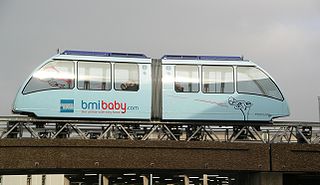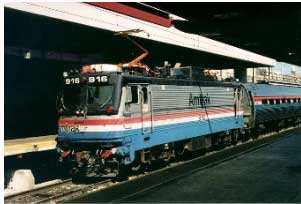Rail rapid transit: What is it?
Definition: Rail rapid transit can be thought of as any of the rail-based systems designed to convey, move, transport high numbers of passengers from points A to B pretty much insulated (isolated, separated) from other transportation modes using their own (dedicated) rights-of-way incorporating a guideway of one kind or another.
These can run along the surface (grade or ground level), be elevated (above ground level) or be located subsurface (below or beneath ground or grade level) or consist of combinations of any or all of the above. Their means of motive power can incorporate everything from conventional (e.g., battery, diesel and electric) to the more unconventional (in this case atmospheric; dual-mode; evacuated-tube, vacuum; fuel-cell; hybrid; magnetic levitation or electromagnetic induction; or whatever else is out there that I am forgetting or simply do not know about) propulsion means or technology.
And, they must be reasonably fast.
And this is important because?
Well, if you consider the history, there were places even as far back as the late 1700s, investigating the efficacies of different transportation modes to satisfy different needs or as a means to improve upon what was already available and currently in use.

In inner cities people at some point sought to move beyond or outside their normal orbits and, at first, streetcars, whether animal or electrically powered, enabled numbers of people to realize this.
There also was a time when mass (high capacity), public transportation fell into disfavor with the advent of the automobile and diesel-powered transit bus, primarily, and many such systems shuttled passengers to and fro for the last time starting in the early 1900s. Some, for one reason or another, never shut down.
Which brings us to today.
Travel the world over and remarkable is what one can find: 1) magnetically levitated trains (maglev) in Shanghai, China and in Japan; 2) Hong Kong has what is referred to as the MTR; 3) London has its Underground; 4) New York its subways, 472 stations strong and the most of any metro transit system anywhere, etcetera, etcetera, etcetera. There is so much more.

Not so much fitting the rapid-rail definition but worth noting nonetheless are the above-ground or elevateds (in railroad vernacular, “elevateds” is actually an accepted term) some of which have been around for more than 100 years now.
In the United States where these can be found are Baltimore (subway, portions of which are elevated), Chicago (with its aptly named “L”), Detroit (people mover), Las Vegas (monorail and people mover), Miami (people mover), Morgantown, W.Va. (people mover or personal rapid transit), New York, Oakland (airport shuttle), Philadelphia (subway, portions of which are elevated), Phoenix (airport shuttle), San Francisco Bay Area, Seattle (monorail) and Tampa (airport shuttle).
The advantages of these are obvious.
- Dedicated rights-of-way – no interference from intersecting traffic – automotive, bicycle, pedestrian
- Energy efficient – providing for lower operating costs overall
- Frequent
- High capacity – can haul comparatively large numbers of passengers
- Low- or non-polluting
- Reliable
- Safe
But, there are downsides too.
- Blight – Infrastructure can be unsightly
- Electrocution hazard – Existence of third-rail a potential danger
- Expense – cost to build, operate and maintain can be pricey
- Limited reach – Don’t always go to places people want or need to get to
- Noise – Horns and wheels rolling on rails can be loud
And, the newest developments and designs cannot be overlooked.
These include the so-called Hyperloop and Loop systems, VECTORR™, skyTran™, CyberTran, ET3, Tubular Rail, and other approaches along these lines.
The missing link
Knowledge is power. And, the more informed one is about the different approaches, alternatives either available or in use or under development, the more prepared one is when it comes to knowledge regarding system selection possibility for now and in the future.
(Disclosure: I wrote a book evaluating three systems at the time under development in my book: The Departure Track: Railways of Tomorrow, which was published in Dec. 2013. These systems in the order covered are: CyberTran, skyTran™ and VECTORR™. The book, in effect, is an independent, impartial, semi-technical review of the trio of aforementioned systems. And, what prompted me to want to write such a book is as I, in no uncertain terms, point out is that transportation in its present incarnation is, in a word, unsustainable. I believe there is something better and there is).

Why is HSR needed? Though some may argue it isn’t, there are 40 million people living in state. It is estimated that by 2060 ten million more will be added. Many will visit as tourists.
Understanding this, HSR provides a very efficient, low- or non-polluting, reliable, frequent, comparatively lower-cost, safe and comfortable means of connecting people and cities and does so sustainably which means it’s made to last. Many other countries have them. Others are building, while still others are getting ready to. All of these countries cannot and are not wrong in their decisions to go that route.
And, where operating, such fast-rail systems all have captured significant market share. Two HSR networks, by the way, are profitable endeavors.
So, what are all of these rail systems all about? At minimum, their aim is to bring better balance to transportation overall and it is working.
HSR is a mainstay in the transportation realm and this will continue to be the case until something better comes along.
This post last revised on May 23, 2020 @ 6:35 a.m. Pacific Daylight Time.
– Alan Kandel

With the development of our “global village” concept it should be possible for many people not to need to travel between home and work-place. Such journeys are wasteful in terms of personal time, cost, pollution, energy, etc.
What the energy savers and anti polluters might well be doing is to proclaim this simple message of the better use of the internet for work-related messages. They could also encourage those who need a change of environment as a place to work, other than their homes, to meet in local work-shops run by private or local authorities, where the same facilities are available at low cost per user as compared to the office.
DAvid is invited to visit the Innovative Transportation Technologies website for current information on automated electric technologies that few know about and have great potential: https://faculty.washington.edu/jbs/itrans Others welcome as well. Coverage is global and updated periodically.
People have the need to travel around, work together, talk in person, etc.